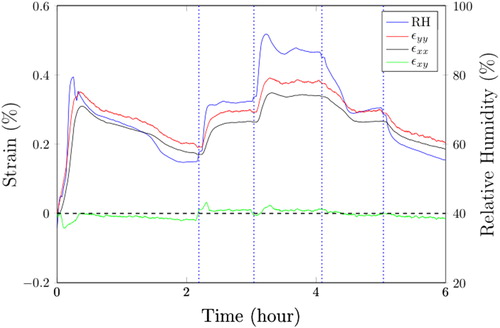1. Introduction
During usual dental restoration procedures, the mouth and so the dental tissues are under humidity and temperature conditions that may affect the bonding efficiency, especially on dentin (Goodis et al. Citation1990; Besnault and Attal Citation2001). The Relative Humidity (RH) has been measured in vivo by Plasmans et al. (Citation1994), and ranges between 75% and 95% in the mouth depending on the geographical location. It can be lowered by the practitioner down to 30% via a rubber dam. Thus, in clinical situation, RH can vary significantly. So, it is crucial to assess the impact of RH on the morphological and mechanical properties of dentin to better understand its impact on the restored tooth properties and further longevity. In particular, it is important to know if dentin inflates with RH, as it may induce significant dimensional variations and thus stresses in the tooth (Wood et al. Citation2003). Similarly, it is important to know the effect of RH on elastic properties of the dentin.
2. Methods
Dentin beams of few millimetres were carefully cutted to have plane and perpendicular faces. They were placed in a compression device, inside an environmental chamber, allowing to control both the temperature and the relative humidity (RH).
An optical microscope enables a continuous measurement of the surfacic strain on the dentin through DIC.
We imposed various RH steps. We measured for each RH step the free hydric dilatation of the dentin. We also imposed a compression on the sample at each RH step, while being careful to remain in the elastic regime. This enabled us to measure one Young modulus and one Poisson ratio of each of our sample as a function of humidity.
3. Results and discussion
show a typical dilatation of a dentin sample with time, as the Relative Humidity changes. We observe that the strain follows well the changes in RH, while being slightly anisotropic.
Figure 1. Time evolution of the Relative Humidity (RH) and of the associated strains measured on free dentin.

From that, we were able to measure that the strain is proportional to the RH, and thus determine the hydric dilatation coefficients of the dentin.
At the same time, we measured the elastic properties and observed that it is not affected by the RH (in the range we have explored).
4. Conclusions
The coefficient of hygroscopic expansion of dentin was measured for the first time to the authors knowledge. It was found to be able to induce significant strain during dental restoration, larger than the ones induced by thermal variations.
The dilatation of dentin was found to be slightly anisotropic, an effect likely related to the anisotropic tubular organisation of the collagen and hydroxyapatite mineral in the dentin.
Additional information
Funding
References
- Besnault C, Attal J-P. 2001. Influence of a simulated oral environment on dentin bond strength of two adhesive systems. Am J Dent. 14(6):367–372.
- Goodis HE, White JM, Gamm B, Watanabe L. 1990. Pulp chamber temperature changes with visible-light-cured composites in vitro. Dent Mater. 6(2):99–102.
- Plasmans P, Creugers NHJ, Hermsen RJ, Vrijhoef M. 1994. Intraoral humidity during operative procedures. J Dent. 22(2):89–91.
- Wood JD, Wang R, Weiner S, Pashley DH. 2003. Mapping of tooth deformation caused by moisture change using moiré interferometry. Dent Mater. 19(3):159–166.
